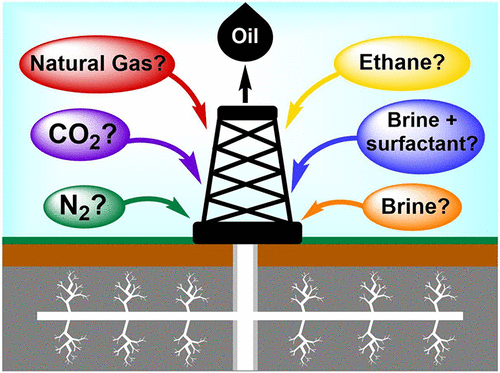当前位置:
X-MOL 学术
›
Energy Fuels
›
论文详情
Our official English website, www.x-mol.net, welcomes your
feedback! (Note: you will need to create a separate account there.)
A Literature Review of CO2, Natural Gas, and Water-Based Fluids for Enhanced Oil Recovery in Unconventional Reservoirs
Energy & Fuels ( IF 5.2 ) Pub Date : 2020-03-25 , DOI: 10.1021/acs.energyfuels.9b03658 Lauren C. Burrows 1, 2 , Foad Haeri 1, 3 , Patricia Cvetic 1, 3 , Sean Sanguinito 1, 3 , Fan Shi 1, 3 , Deepak Tapriyal 1, 3 , Angela Goodman 1 , Robert M. Enick 4
Energy & Fuels ( IF 5.2 ) Pub Date : 2020-03-25 , DOI: 10.1021/acs.energyfuels.9b03658 Lauren C. Burrows 1, 2 , Foad Haeri 1, 3 , Patricia Cvetic 1, 3 , Sean Sanguinito 1, 3 , Fan Shi 1, 3 , Deepak Tapriyal 1, 3 , Angela Goodman 1 , Robert M. Enick 4
Affiliation

|
Primary oil recovery from fractured unconventional formations, such as shale or tight sands, is typically less than 10%. The development of an economically viable enhanced oil recovery (EOR) technique applicable to unconventional liquid reservoirs (ULRs) would lead to tremendous increases in domestic oil production. Although injection techniques such as waterflooding and CO2 EOR have proven profitable in conventional formations for decades, EOR in ULRs presents a far more difficult challenge. The extremely low permeability and mixed wettability of unconventional formations are the foremost obstacles to success. Because of the challenges associated with water-based EOR techniques (a.k.a., chemical EOR) in shale, several nonaqueous injection fluids have been considered, including CO2, natural gas, and (to a lesser degree) nitrogen. All these fluids have significantly lower viscosities than water, allowing them to more easily penetrate shale nanopores. Unlike water, they also each possess some degree of miscibility with oil, which enables the gas to extract oil through a combination of mechanisms. Based on laboratory-scale experimentation, CO2 and rich natural gas (methane-rich natural gas containing high concentrations of ethane, propane, and butane) are the most promising EOR fluids. The interpretation of results from field tests in the Bakken and Eagle Ford formations have been complicated by interference of frac-hits or well-bashing caused by hydraulic fracturing at nearby wells. In this review we cover mechanisms, laboratory experiments, numerical simulations, and field tests involving high-pressure CO2, natural gas, ethane, nitrogen, and water.
中文翻译:

非常规油藏中CO 2,天然气和水基流体用于提高采油率的文献综述
从裂缝性非常规地层(如页岩或致密砂岩)中回收的一次采油量通常不到10%。适用于非常规液体储层(ULR)的经济可行的强化采油(EOR)技术的发展将导致国内石油产量的巨大增长。尽管数十年来,诸如注水和CO 2 EOR的注入技术已被证明在常规地层中是有利可图的,但ULR中的EOR提出了更为困难的挑战。非常规地层的极低渗透率和混合润湿性是成功的首要障碍。由于页岩中的水性EOR技术(又称化学EOR)带来的挑战,已考虑了几种非水注入流体,包括CO 2,天然气和(程度较小的)氮气。所有这些流体的粘度都比水低得多,从而使它们更容易渗透到页岩纳米孔中。与水不同,它们各自还具有与油的某种程度的混溶性,这使气体可以通过多种机制来提取油。基于实验室规模的实验,CO 2富天然气(富含高浓度乙烷,丙烷和丁烷的富甲烷天然气)是最有前途的EOR流体。由于附近井的水力压裂导致压裂或压井的干扰,对Bakken和Eagle Ford地层的现场测试结果的解释变得复杂。在这篇综述中,我们涵盖了涉及高压CO 2,天然气,乙烷,氮气和水的机理,实验室实验,数值模拟和现场测试。
更新日期:2020-03-25
中文翻译:

非常规油藏中CO 2,天然气和水基流体用于提高采油率的文献综述
从裂缝性非常规地层(如页岩或致密砂岩)中回收的一次采油量通常不到10%。适用于非常规液体储层(ULR)的经济可行的强化采油(EOR)技术的发展将导致国内石油产量的巨大增长。尽管数十年来,诸如注水和CO 2 EOR的注入技术已被证明在常规地层中是有利可图的,但ULR中的EOR提出了更为困难的挑战。非常规地层的极低渗透率和混合润湿性是成功的首要障碍。由于页岩中的水性EOR技术(又称化学EOR)带来的挑战,已考虑了几种非水注入流体,包括CO 2,天然气和(程度较小的)氮气。所有这些流体的粘度都比水低得多,从而使它们更容易渗透到页岩纳米孔中。与水不同,它们各自还具有与油的某种程度的混溶性,这使气体可以通过多种机制来提取油。基于实验室规模的实验,CO 2富天然气(富含高浓度乙烷,丙烷和丁烷的富甲烷天然气)是最有前途的EOR流体。由于附近井的水力压裂导致压裂或压井的干扰,对Bakken和Eagle Ford地层的现场测试结果的解释变得复杂。在这篇综述中,我们涵盖了涉及高压CO 2,天然气,乙烷,氮气和水的机理,实验室实验,数值模拟和现场测试。









































 京公网安备 11010802027423号
京公网安备 11010802027423号